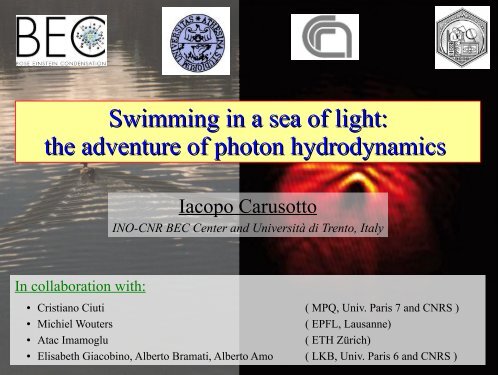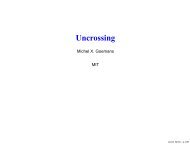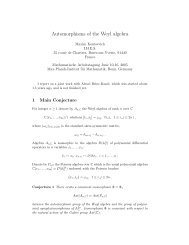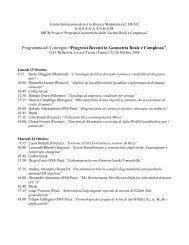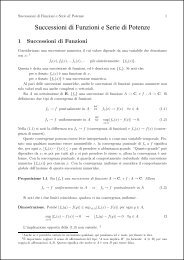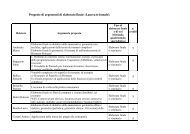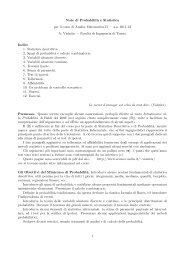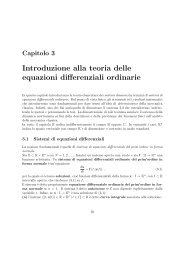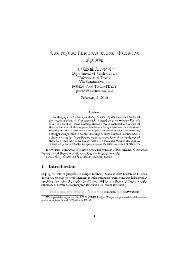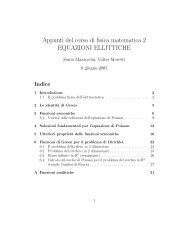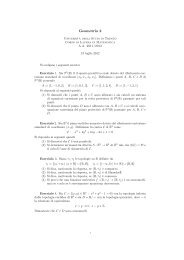Swimming in a sea of light: the adventure of photon hydrodynamics
Swimming in a sea of light: the adventure of photon hydrodynamics
Swimming in a sea of light: the adventure of photon hydrodynamics
Create successful ePaper yourself
Turn your PDF publications into a flip-book with our unique Google optimized e-Paper software.
<strong>Swimm<strong>in</strong>g</strong> <strong>in</strong> a <strong>sea</strong> <strong>of</strong> <strong>light</strong>:<br />
<strong>the</strong> <strong>adventure</strong> <strong>of</strong> <strong>photon</strong> <strong>hydrodynamics</strong><br />
Iacopo Carusotto<br />
INO-CNR BEC Center and Università di Trento, Italy<br />
In collaboration with:<br />
● Cristiano Ciuti ( MPQ, Univ. Paris 7 and CNRS )<br />
● Michiel Wouters ( EPFL, Lausanne)<br />
● Atac Imamoglu ( ETH Zürich)<br />
● Elisabeth Giacob<strong>in</strong>o, Alberto Bramati, Alberto Amo ( LKB, Univ. Paris 6 and CNRS )
Newton's corpuscular <strong>the</strong>ory <strong>of</strong> <strong>light</strong> (“Opticks”(<br />
“Opticks”,, 1704)<br />
Light is composed <strong>of</strong> material corpuscles<br />
●<br />
●<br />
●<br />
different colors correspond to corpuscles <strong>of</strong> different k<strong>in</strong>d<br />
corpuscles travel <strong>in</strong> free space along straight l<strong>in</strong>es<br />
refraction orig<strong>in</strong>ates from attraction by material bodies<br />
Implicit assumption: corpuscles do not <strong>in</strong>teract with each o<strong>the</strong>r<br />
●<br />
●<br />
if <strong>the</strong>y <strong>in</strong>teracted via collisions, <strong>the</strong>y could form a fluid like water or air<br />
to my knowledge, no historical trace <strong>of</strong> Newton hav<strong>in</strong>g ever thought <strong>in</strong> <strong>the</strong>se terms.
Huygens wave <strong>the</strong>ory <strong>of</strong> <strong>light</strong> (“traité(<br />
de la lumière”, , 1690)<br />
Newton's corpuscular <strong>the</strong>ory soon defeated by rival wave thory <strong>of</strong> <strong>light</strong><br />
●<br />
●<br />
●<br />
Young two slit <strong>in</strong>terference experiment<br />
diffraction from aperture:<br />
Huygens-Fresnel pr<strong>in</strong>ciple <strong>of</strong> secondary waves<br />
polarization effects<br />
Arago-Poisson white spot<br />
●<br />
●<br />
●<br />
Poisson ridiculed wave <strong>the</strong>ory predict<strong>in</strong>g bright spot <strong>in</strong> center <strong>of</strong> shade <strong>of</strong> circular object<br />
us<strong>in</strong>g Fresnel-Huygens <strong>the</strong>ory <strong>of</strong> diffraction....<br />
… but Arago actually observed spot <strong>in</strong> early '800!!<br />
(actually appear to have been first observed by Maraldi <strong>in</strong> 1723)<br />
impossible to expla<strong>in</strong> via corpuscular <strong>the</strong>ory:<br />
strong support to wave <strong>the</strong>ory
Photo-electric effect:<br />
●<br />
●<br />
●<br />
There are more th<strong>in</strong>gs <strong>in</strong> heaven and earth, Horatio,<br />
Than are dreamt <strong>of</strong> <strong>in</strong> your philosophy<br />
energy <strong>of</strong> emitted electrons depends<br />
on <strong>light</strong> frequency and not <strong>in</strong>tensity<br />
E<strong>in</strong>ste<strong>in</strong> expla<strong>in</strong>s photoelectric effect<br />
<strong>in</strong> terms <strong>of</strong> <strong>light</strong> quanta (1905)<br />
concept <strong>of</strong> quantum already postulated<br />
by Planck to correct black-body catastrophe<br />
But wavy nature <strong>of</strong> <strong>light</strong> persists:<br />
●<br />
●<br />
dual wave-particle properties <strong>of</strong> <strong>photon</strong>s<br />
(and electrons → de Broglie wavelength):<br />
Young two slit experiment:<br />
➢ every <strong>photon</strong> hits screen at random position<br />
➢ probability distribution determ<strong>in</strong>ed<br />
by classical diffraction <strong>the</strong>ory
In vacuo:<br />
●<br />
●<br />
Light-<strong>light</strong> scatter<strong>in</strong>g<br />
optical <strong>photon</strong>-<strong>photon</strong> scatter<strong>in</strong>g mediated<br />
by (virtual) electron-positron pairs<br />
far <strong>of</strong>f-resonance process ( e+ -e - energy ≈ MeV)<br />
● for ћω « mc<br />
2<br />
: ≃ 4 ħ 2<br />
ħ <br />
6<br />
with ћ / mc =0.4 pm<br />
m 2 c 2<br />
mc 2<br />
γ<br />
γ<br />
γ<br />
γ<br />
In nonl<strong>in</strong>ear optical medium:<br />
●<br />
●<br />
electronic excitations available at optical energies ( ≈ eV)<br />
<strong>photon</strong>-<strong>photon</strong> scatter<strong>in</strong>g due to nonl<strong>in</strong>ear polarization<br />
P = χ (1) E + χ (3) E E E<br />
Four-wave mix<strong>in</strong>g:<br />
●<br />
●<br />
●<br />
stimulated <strong>photon</strong>-<strong>photon</strong> collision<br />
still requires strong <strong>light</strong> <strong>in</strong>tensity and coherence<br />
first observed <strong>in</strong> <strong>the</strong> '60s us<strong>in</strong>g laser sources
Fluids and gases: a mostly corpuscular history<br />
Demokritus' atomistic model <strong>of</strong> matter:<br />
●<br />
●<br />
●<br />
<strong>in</strong>divisible atoms as solid objects mov<strong>in</strong>g <strong>in</strong> vacuo<br />
different material consist <strong>of</strong> different k<strong>in</strong>ds <strong>of</strong> atoms<br />
mostly a philosophical idea, scientifically demonstrated only <strong>in</strong> modern<br />
times<br />
Expla<strong>in</strong>s <strong>in</strong> microscopic terms <strong>the</strong>rmodynamics and chemistry:<br />
●<br />
●<br />
●<br />
●<br />
ideal gas laws, k<strong>in</strong>etic <strong>the</strong>ory <strong>of</strong> gases<br />
fundamental laws <strong>of</strong> chemical reactions<br />
molecular dynamics understand<strong>in</strong>g <strong>of</strong> condensed matter phenomena<br />
statistical fluctuations and Brownian motion<br />
Demokritus
Quantum mechanics: wave nature <strong>of</strong> matter<br />
de Broglie wave (postulated <strong>in</strong> 1924):<br />
●<br />
●<br />
●<br />
<strong>in</strong>troduced to expla<strong>in</strong> Bohr's model <strong>of</strong> atomic structure<br />
wavelength λ=h/p<br />
soon measured as <strong>in</strong>terference pattern <strong>of</strong> electrons<br />
(Davisson and Germer, 1927)<br />
Apparent at ultralow temperatures:<br />
● <strong>the</strong>rmal de Broglie wavelength λ th<br />
=(2πћ/mk B<br />
T) 1/2<br />
●<br />
●<br />
comparable to <strong>in</strong>terparticle distance<br />
wave nature <strong>of</strong> particles starts to matter<br />
completely different behaviour <strong>of</strong> macroscopic<br />
systems<br />
depend<strong>in</strong>g on <strong>in</strong>teger vs. half-<strong>in</strong>teger sp<strong>in</strong> <strong>of</strong><br />
constituent particles<br />
sketch from Ketterle group website
Fermions<br />
Many-body wavefunction antisymmetric under exchange <strong>of</strong> two particles<br />
At most one particle at a time can occupy a given quantum state<br />
Ground state: all levels filled upto to Fermi energy E F<br />
Fermi pressure prevents collapse and stabilizes matter:<br />
➢<br />
➢<br />
electrons <strong>in</strong> atoms and metals<br />
neutrons <strong>in</strong> neutron stars formed by gravitational collapse<br />
(when gravity overcomes Fermi pressure <strong>of</strong> electrons,<br />
i.e. for star mass above 1.44 solar masses )
Bosons<br />
Arbitrary number <strong>of</strong> particles occupy same quantum state:<br />
● ground state: all boson <strong>in</strong>to lowest-energy state,<br />
<strong>the</strong> Bose-E<strong>in</strong>ste<strong>in</strong> condensate<br />
● momentum-space condensation <strong>in</strong>to k=0 state<br />
● real-space condensation only <strong>in</strong> trapped geometries<br />
Even <strong>in</strong> <strong>the</strong> presence <strong>of</strong> <strong>in</strong>teractions:<br />
➢ macroscopic fraction <strong>of</strong> atoms <strong>in</strong>to same state<br />
➢ same macroscopic wavefunction<br />
➢ matter waves <strong>of</strong> all atoms “oscillate at <strong>the</strong> unison”<br />
Picture from Ketterle group website<br />
Macroscopic wavefunction dynamics: Gross-Pitaevskii<br />
equation:<br />
i ħ∂ t =− ħ2<br />
2m ∇ 2 V g∣∣ 2 <br />
●<br />
●<br />
<strong>in</strong>dependent-particle evolution: Schroed<strong>in</strong>ger eq.<br />
atom-atom <strong>in</strong>teractions responsible for nonl<strong>in</strong>ear term
BEC: a coherent wave <strong>of</strong> matter<br />
Coherent laser (or radio) e. m. field<br />
E, B fields<br />
Coherent field E = < Ê ><br />
Maxwell equations<br />
Nonl<strong>in</strong>ear polarization <strong>of</strong> medium<br />
Light polarization<br />
↔<br />
↔<br />
↔<br />
↔<br />
↔<br />
↔<br />
Coherent matter field <strong>of</strong> BEC<br />
Matter field Ψ<br />
Coherent field Ψ = < Ψ ><br />
Gross-Pitaevskii eq.<br />
Atom-atom <strong>in</strong>teractions<br />
Atomic sp<strong>in</strong><br />
∇ 2 E− 1 ∂ 2 E<br />
c 2 ∂ t = 4<br />
2 c 2<br />
∂ 2 P<br />
∂ t 2<br />
↔<br />
i ħ ∂ ħ2<br />
=−<br />
∂ t 2m ∇ 2 V g∣∣ 2 <br />
Atoms <strong>of</strong> Bose-E<strong>in</strong>ste<strong>in</strong> condensate effectively forget <strong>the</strong>ir corpuscular nature<br />
and behave as a macroscopic coherent matter wave !!
Superfluidity<br />
● onset <strong>of</strong> friction for v > v cr<br />
Strik<strong>in</strong>g consequence <strong>of</strong> coherent wave nature <strong>of</strong> matter<br />
●<br />
●<br />
collective behavior with all particles <strong>in</strong>volved <strong>in</strong> system dynamics<br />
<strong>in</strong>teract<strong>in</strong>g Bose gas: low-energy excitations are sound modes, not s<strong>in</strong>gle-particle<br />
ones<br />
Impurity mov<strong>in</strong>g through BEC:<br />
●<br />
no energy dissipation for v < v cr<br />
, superfluid behaviour<br />
v < v cr<br />
v > v cr<br />
Founta<strong>in</strong> effect <strong>in</strong> liquid He<br />
R. On<strong>of</strong>rio, et al. PRL 85, 2228 (2000)
Landau <strong>in</strong>terpretation<br />
Impurity mov<strong>in</strong>g through BEC:<br />
→ Landau critical speed v cr<br />
= m<strong>in</strong> k<br />
[ω(k)/k]<br />
→ localized disturbance for v < v cr<br />
, superfluid behaviour, no energy dissipation<br />
→ complex density modulation pattern for v > v cr<br />
phonons radiated <strong>in</strong>to modes satisfy<strong>in</strong>g Cerenkov condition ω(k) = k · v<br />
v < v cr<br />
v > v cr
In a nutshell...<br />
So far we have seen that:<br />
Bose-condensed bosonic atoms below T BEC<br />
forget <strong>the</strong>ir corpuscular nature<br />
and behave as a macroscopic coherent matter wave<br />
Conversely:<br />
could one make <strong>light</strong> to forget its wave nature and behave<br />
as a hydrodynamic gas <strong>of</strong> <strong>in</strong>teract<strong>in</strong>g <strong>photon</strong>s?<br />
A first step:<br />
observe superfluid behaviour <strong>in</strong> coherent <strong>light</strong> wave
The optical system under <strong>in</strong>vestigation
Superfluid <strong>hydrodynamics</strong> <strong>of</strong> <strong>photon</strong>s<br />
Non-<strong>in</strong>teract<strong>in</strong>g<br />
polaritons<br />
v > v cr<br />
non-superfluid behaviour<br />
v < v cr<br />
superfluid behaviour<br />
IC and C.Ciuti, PRL 93, 166401 (2004)
Experimental data: superfluid behaviour<br />
superfluid<br />
flow<br />
scatter<strong>in</strong>g<br />
on defect<br />
<strong>in</strong>crease polariton density<br />
Figure from LKB-P6 group:<br />
J.Lefrère, A.Amo, S.Pigeon, C.Adrados, C.Ciuti, IC, R. Houdré, E.Giacob<strong>in</strong>o, A.Bramati, Observation <strong>of</strong><br />
Superfluidity <strong>of</strong> Polaritons <strong>in</strong> Semiconductor Microcavities, Nature Phys. 5, 805 (2009)<br />
Theory: IC and C. Ciuti, PRL 93, 166401 (2004).
Cerenkov wake <strong>in</strong> supersonic flow<br />
Experiment<br />
Theory<br />
Expt with atomic BEC<br />
Expt. image from JILA<br />
(P. Engels, E. Cornell).<br />
Theory IC, Hu, Coll<strong>in</strong>s, Smerzi,<br />
PRL 97, 260403 (2006)<br />
Super-sonic flow hitt<strong>in</strong>g a defect:<br />
●<br />
Cerenkov conical wave, aperture s<strong>in</strong>(φ) = c s<br />
/ v<br />
●<br />
s<strong>in</strong>gle-particle parabolic precursors<br />
Expt with duck<br />
J.Lefrère, A.Amo, S.Pigeon, C.Adrados, C.Ciuti, IC, R. Houdré, E.Giacob<strong>in</strong>o, A.Bramati,Nature Phys. 5, 805 (2009); IC and C. Ciuti, PRL 93, 166401 (2004).
Superfluid <strong>hydrodynamics</strong> observed <strong>in</strong> fluid <strong>of</strong> <strong>light</strong>!!<br />
But still a number <strong>of</strong> open challenges...<br />
Interactions are more effective <strong>in</strong> coherent wave state than <strong>in</strong> normal state<br />
New frontier: hydrodynamic behaviour <strong>of</strong> <strong>light</strong> <strong>in</strong> normal gas<br />
<strong>of</strong> corpuscular <strong>photon</strong>s<br />
So far:<br />
●<br />
ballistic propagation <strong>of</strong> <strong>photon</strong>s <strong>of</strong> a <strong>the</strong>rmal lamp source<br />
Hydrodynamic behaviour:<br />
●<br />
●<br />
collisional mean-free path for <strong>photon</strong>-<strong>photon</strong> collisions shorter<br />
than wavelength <strong>of</strong> spatial modulation<br />
requires <strong>photon</strong>-<strong>photon</strong> <strong>in</strong>teractions much stronger than <strong>in</strong> standard media
Strongly <strong>in</strong>teract<strong>in</strong>g atomic gases:<br />
●<br />
A strategy to enhance <strong>photon</strong>-<strong>photon</strong> <strong>in</strong>teractions<br />
exploit Feshbach resonance effect<br />
on molecular <strong>in</strong>termediate state<br />
●<br />
scatter<strong>in</strong>g length<br />
[<br />
a=a 1− bg<br />
<br />
] B−B 0<br />
● scatter<strong>in</strong>g cross section σ = 8 π a<br />
2<br />
figure from Ketterle group website<br />
Optical molecule:<br />
●<br />
●<br />
biexciton <strong>in</strong> solid-state material: 2e's+2h's complex<br />
can be excited via two-<strong>photon</strong> absorption<br />
Photon-<strong>photon</strong> collisions resonant on biexciton <strong>in</strong>termediate state<br />
In nonl<strong>in</strong>ear optical terms: resonant two-<strong>photon</strong> absorption<br />
M. Wouters, Phys. Rev. B 76, 045319 (2007); I. Carusotto, T. Volz, A. Imamoglu, arXiv:1002.2613
Simplest signature <strong>of</strong> <strong>photon</strong>-<strong>photon</strong> <strong>in</strong>teractions at s<strong>in</strong>gle <strong>photon</strong> level<br />
●<br />
●<br />
●<br />
Photon blockade<br />
entrance <strong>of</strong> first <strong>photon</strong> blocks entrance entrance <strong>of</strong> a second<br />
after one <strong>photon</strong> has exited, system has to reload.<br />
dead time between emitted <strong>photon</strong>s, anti-bunched stream, sub-Poissonian<br />
statistics<br />
●<br />
●<br />
observed <strong>in</strong> high-f<strong>in</strong>esse optical cavities with 2-level atoms, but hardly scalable<br />
analog <strong>of</strong> Coulomb blockade <strong>of</strong> mesoscopic conductors<br />
Coulomb blockade<br />
figure D. J. Paul, Cambridge, 2006<br />
from: Birnbaum et al., Nature 436, 87 (2005)
Strong <strong>in</strong>teractions prevent particles from overlapp<strong>in</strong>g<br />
One-dimensional geometry:<br />
●<br />
●<br />
●<br />
Tonks-Girardeau gas <strong>of</strong> impenetrable bosons<br />
strong lateral conf<strong>in</strong><strong>in</strong>g potential, only axial motion<br />
bosons can not cross, zeros <strong>in</strong> wavefunction when overlapp<strong>in</strong>g<br />
Girardeau Bose-Fermi mapp<strong>in</strong>g: Bose gas <strong>in</strong>herits some fermionic<br />
properties<br />
e.g Fermi pressure<br />
●<br />
dynamics: quantum Newton's craddle with ultracold atoms<br />
K<strong>in</strong>oshita, Wenger, Weiss, Nature 440, 900 (2006)
Necklace <strong>of</strong> cavities: non-equilibrium Bose-Hubbard model<br />
Optical realization:<br />
●<br />
necklace <strong>of</strong> cavities coupled by optical tunnel<strong>in</strong>g processes<br />
●<br />
blockade regime: on-site nonl<strong>in</strong>earity U » tunnel<strong>in</strong>g J<br />
●<br />
cavities driven by coherent pump, <strong>photon</strong>s radiatively decay<br />
●<br />
non-equilibrium state: driven-dissipative system,<br />
stationary state from dynamical balance <strong>of</strong> pump<strong>in</strong>g and losses<br />
●<br />
spectroscopic signature <strong>of</strong> strongly correlated many-body<br />
states<br />
●<br />
nature <strong>of</strong> states can be <strong>in</strong>ferred from <strong>photon</strong> statistics<br />
<strong>of</strong> emitted <strong>light</strong><br />
I. Carusotto, D. Gerace, H. Tureci, S. De Liberato, C. Ciuti, A. Imamoglu, Phys. Rev. Lett. 103, 033601 (2009).
Conclusions and perspectives<br />
Experimental study <strong>of</strong> superfluid <strong>light</strong>:<br />
●<br />
●<br />
suppression <strong>of</strong> scatter<strong>in</strong>g for sub-sonic flow<br />
Cerenkov wake for super-sonic flow<br />
Theoretical study <strong>of</strong> strongly <strong>in</strong>teract<strong>in</strong>g <strong>photon</strong> gases:<br />
●<br />
●<br />
biexcitonic Feshbach resonances<br />
Tonks-Girardeau gas <strong>of</strong> fermionized <strong>photon</strong>s <strong>in</strong> 1D<br />
A new frontier:<br />
●<br />
●<br />
hydrodynamic behaviour <strong>in</strong> normal gas <strong>of</strong> corpuscular<br />
<strong>photon</strong>s<br />
second sound <strong>in</strong> superfluid <strong>photon</strong> fluid at f<strong>in</strong>ite T<br />
● ultimate pro<strong>of</strong> <strong>of</strong> corpuscular nature <strong>of</strong> <strong>light</strong> !<br />
<strong>photon</strong>s! x<br />
more details <strong>in</strong> a forthcom<strong>in</strong>g paper on Europhysics News !!
Thanks<br />
for your<br />
attention !!!
If you are a brave young re<strong>sea</strong>rcher <strong>in</strong>terested <strong>in</strong> a comb<strong>in</strong>ation <strong>of</strong> ...<br />
image: JILA group<br />
quantum optics<br />
polariton condensates<br />
<strong>the</strong>ory and experiments<br />
<strong>in</strong> ultracold atoms<br />
acoustic black holes<br />
… don't hesitate, but go for<br />
PhD and PostDoc positions available at BEC-Trento<br />
contact us at: bec<strong>in</strong>fm@science.unitn.it
The new frontier: strongly <strong>in</strong>teract<strong>in</strong>g <strong>photon</strong>s<br />
analogy between coherent <strong>light</strong> and atomic condensates based<br />
on a weak-<strong>in</strong>teraction condition<br />
large particle <strong>in</strong>volved <strong>in</strong> <strong>the</strong> dynamics, <strong>in</strong> particular mean-field <strong>in</strong>teraction energy<br />
what if small number <strong>of</strong> particles enough to give <strong>the</strong> same <strong>in</strong>teraction?<br />
Helium vs atomic condensates
Non-equilibrium condition:<br />
<strong>photon</strong>s lost and re<strong>in</strong>jected cont<strong>in</strong>uously<br />
stationary state: dynamical equilibrium <strong>of</strong> pump<strong>in</strong>g and losses,<br />
not <strong>the</strong>rmal equilibrium<br />
driven-dissipative system<br />
Modified GPE<br />
i ħ ∂ t<br />
=− ħ2<br />
2m ∇ 2 V g∣∣ 2 <br />
Chemical potential mu not determ<strong>in</strong>ed by equation <strong>of</strong> state, but freely<br />
tuned by <strong>in</strong>cident laser frequency<br />
New features: zebra Cerenkov when <strong>photon</strong> fluid is close to an <strong>in</strong>stability


